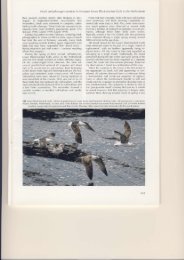Identification of American Herring Gull in a western European context
Identification of American Herring Gull in a western European context
Identification of American Herring Gull in a western European context
You also want an ePaper? Increase the reach of your titles
YUMPU automatically turns print PDFs into web optimized ePapers that Google loves.
<strong>Identification</strong> <strong>of</strong> <strong>American</strong> <strong>Herr<strong>in</strong>g</strong> <strong>Gull</strong> <strong>in</strong> a <strong>western</strong> <strong>European</strong> <strong>context</strong>the size <strong>of</strong> Europe, that the North <strong>American</strong>population comprises more than just one ‘type’.Indeed, Jonsson & Mactavish (2001) suggestedthat the populations w<strong>in</strong>ter<strong>in</strong>g <strong>in</strong> Newfoundlandand <strong>in</strong> the Niagara Falls regions, respectively,exhibit sufficiently consistent differences <strong>in</strong>morphology and w<strong>in</strong>g-tip pattern to <strong>in</strong>dicate thatthey represent dist<strong>in</strong>ct phenotypes. There alsoappear to be differences between East and WestCoast birds (Dwight 1925, Sibley 2000, KlausMall<strong>in</strong>g Olsen pers comm) but most <strong>of</strong> thepublished <strong>in</strong>formation on the ‘West coast type’ israther vague and anecdotal <strong>in</strong> nature. No doubtfurther sampl<strong>in</strong>g and analysis <strong>of</strong> mtDNA material,comb<strong>in</strong>ed with more systematic field observationswill improve our understand<strong>in</strong>g <strong>of</strong> variationwith<strong>in</strong> smithsonianus.MoultGenerally speak<strong>in</strong>g, moult <strong>in</strong> smithsonianus issimilar to that <strong>of</strong> argentatus and argenteus as outl<strong>in</strong>edby Grant (1986) but with important clarificationsdescribed by Howell et al (1999). Thetendency for some first-years smithsonianus,apparently orig<strong>in</strong>at<strong>in</strong>g <strong>in</strong> northern latitudes, topostpone their post-juvenile moult until mid-w<strong>in</strong>ter,or even spr<strong>in</strong>g <strong>of</strong> their second calendar-year,mirrors a similar strategy employed by a significantnumber <strong>of</strong> argentatus (Nikander 1996,Howell 2001, pers obs) but overall, moult is <strong>of</strong>little or no significance when it comes to identify<strong>in</strong>g<strong>in</strong>dividual herr<strong>in</strong>g gulls.Structure and characterSmithsonianus averages a large heavily built bird,appear<strong>in</strong>g similar <strong>in</strong> size and proportions toargentatus, thus larger than an average argenteus.Many immatures have a demeanour which recallsfirst- and second-year Glaucous <strong>Gull</strong> due, perhaps,to the comb<strong>in</strong>ation <strong>of</strong> a rather thick, long,bicoloured bill and a tendency to have rather uniformlycoloured underparts.Bill structure averages slightly different too,s<strong>in</strong>ce many smithsonianus have parallel-sidedbills with little gonydeal angle. The bill also averagesslightly longer than <strong>in</strong> <strong>European</strong> <strong>Herr<strong>in</strong>g</strong><strong>Gull</strong>s – but there is overlap.DescriptionsThe follow<strong>in</strong>g accounts treat each age category,juvenile, first-w<strong>in</strong>ter, second-w<strong>in</strong>ter and so on upto adult, <strong>in</strong>dividually and <strong>in</strong> that order.Obviously, there is overlap <strong>in</strong> juvenile and firstw<strong>in</strong>terplumages, and a certa<strong>in</strong> amount <strong>of</strong> duplication<strong>in</strong> their respective accounts is unavoidable.We restrict ourselves to describ<strong>in</strong>g theappearance <strong>of</strong> smithsonianus <strong>in</strong> the w<strong>in</strong>terperiod s<strong>in</strong>ce practically all <strong>of</strong> our first-hand experience,both <strong>in</strong> North America and <strong>in</strong> Europehas been between September and April. Due tothe effects <strong>of</strong> fad<strong>in</strong>g, wear and active moult, thesummer months are considered a much lessreward<strong>in</strong>g time to study gulls and it may be thatthis is a significant factor <strong>in</strong> expla<strong>in</strong><strong>in</strong>g the virtualabsence <strong>of</strong> summer records <strong>of</strong> smithsonianus <strong>in</strong>Europe. However, observations <strong>of</strong> at least twobirds that over-summered <strong>in</strong> Cork <strong>in</strong> 2001(Bird<strong>in</strong>g World 14: 224, 2001) suggest that detection<strong>of</strong> birds <strong>in</strong> first-summer plumage may not beas difficult as might have been imag<strong>in</strong>ed.The extent <strong>of</strong> age-related, seasonal, sexual and<strong>in</strong>dividual variation <strong>in</strong> large gulls is well knownand accounts for many <strong>of</strong> the associated age<strong>in</strong>gand identification problems. The potential for<strong>in</strong>dividual variation that exists <strong>in</strong> most large-gulltaxa and the consequent overlap <strong>in</strong> the appearance<strong>of</strong> many characters has an important bear<strong>in</strong>gon the identification <strong>of</strong> all ‘out-<strong>of</strong>-range’ or vagrantlarge gulls, and this is particularly true whenconsider<strong>in</strong>g claims <strong>of</strong> smithsonianus <strong>in</strong> Europe.While it would be unreasonable to expect everysmithsonianus recorded <strong>in</strong> Europe to correspondexactly with the most ‘classic’ examples portrayed<strong>in</strong> this paper the great majority should, we suggest,be <strong>of</strong> typical appearance. Although everycase should <strong>of</strong> course be considered on its merits,problematic birds (ie, birds with a mix <strong>of</strong> ‘good’and ‘bad’ characters) are arguably more likely tobe unusual-look<strong>in</strong>g <strong>European</strong> <strong>Herr<strong>in</strong>g</strong> <strong>Gull</strong>s thanaberrant or atypical smithsonianus. There willalways be cases <strong>of</strong> contentious birds where it isdifficult or impossible to prove that they are notsmithsonianus, even though birds match<strong>in</strong>g theirappearance would be considered unusual, oreven exceptional, <strong>in</strong> North America. At the risk <strong>of</strong>los<strong>in</strong>g a few records <strong>of</strong> ‘good’ birds, we are<strong>in</strong>cl<strong>in</strong>ed to recommend that, for the time be<strong>in</strong>g,only those birds with the strongest credentials beconsidered ‘acceptable’ <strong>in</strong> Europe.It is impossible <strong>in</strong> a paper such as this to coverthe vast extent <strong>of</strong> variation <strong>in</strong> these gulls. All wecan do is try to def<strong>in</strong>e what we consider the mostuseful identification characters for each agegroup and anticipate the most likely sources <strong>of</strong>confusion. We cannot emphasize enough theimportance <strong>of</strong> acquir<strong>in</strong>g a comprehensive familiaritywith the commoner species <strong>of</strong> large gulland <strong>of</strong> always keep<strong>in</strong>g <strong>in</strong> m<strong>in</strong>d the potential forvariation <strong>in</strong> these birds.4










